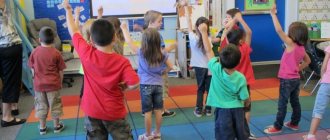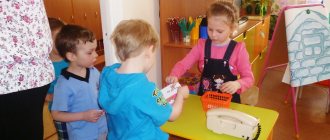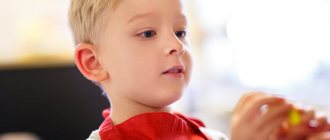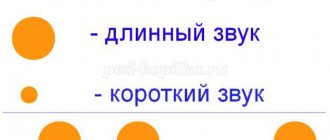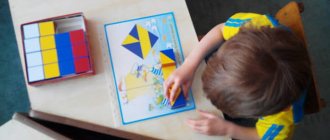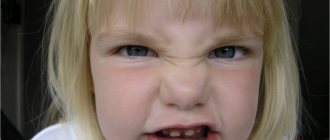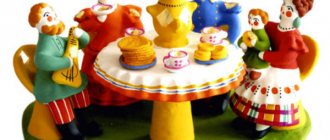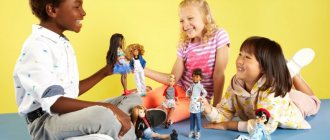Article. Musical education of preschool children.
Article. Musical education of preschool children.
Musical education is the purposeful formation of a child’s personality through the influence of musical art - the formation of interests, needs, abilities, aesthetic attitude to music, and the transfer of experience of musical activity to them7. Therefore, musical education occurs in the process of the child’s assimilation of socially developed methods and actions. The ability to convey a piece of music to children, to introduce them to it, influencing their feelings and thoughts, is a noble and responsible task. The process of musical education should be led by a teacher who is professionally trained, creative in his pedagogical quests, masters the art and loves his students. The theory and practice of musical education of children is constantly being improved, and the creative experience of advanced teachers is widely generalized. The music director must improve his theoretical and professional practical level and pedagogical skills. In this case, the child successfully masters various types of musical activities, if his individual characteristics and age capabilities are taken into account. Musical development is the result of a child’s formation in the process of active musical activity. The individual characteristics of each child are of certain importance8. Development occurs: - in the field of emotions - from impulsive responses to the simplest musical phenomena to more pronounced and varied reactions; - in the field of sensation, perception and hearing - from individual distinctions of musical sounds to a holistic, conscious and active perception of music, to differentiation of pitch, rhythm, timbre, dynamics; - in the area of manifestations of relationships - from unstable hobbies to more stable interests, needs, to the first manifestations of musical taste; - in the field of performing activities - from actions of display, imitation to independent expressive and creative manifestations in singing and musical-rhythmic movement9. Musical education and development require proper organization and targeted training. Music learning is an educational process in which the teacher helps to accumulate musical experience and acquire basic knowledge. In turn, the child actively learns this. Education in general, and education in particular, should “run ahead” of development and “pull it up” with it. Musical development is determined by the process of education and training. The level of development is determined by the behavior of children in music classes, creative manifestations in independent activities. If a child, on his own initiative, willingly sings, dances, plays music and does it expressively and correctly, then we can talk about a fairly high level of musical development. It is very important in the process of musical education to take into account the characteristics and interests of each child. It is necessary to remember about an individually differentiated approach, which helps to monitor the individual development of children, to note the shifts that have occurred in their development and upbringing. During collective lessons, the teacher provides individual tasks of varying degrees of complexity, which makes them attractive to children and does not infringe on their interests. The objectives of musical education in kindergarten are subordinated to the general goal of comprehensive and harmonious education of the child’s personality and are built taking into account the uniqueness of musical art and the age characteristics of preschoolers: 1. Arouse active interest and love for music, develop its correct perception, shape the feelings and experiences of children, stimulate them moral - aesthetic experiences, the ability to be emotionally responsive. 2. Enrich musical experiences by introducing a variety of works and information about them. Z. Introduce to various types of musical activities, teach methods and skills of singing and musical and rhythmic movements, playing children's musical instruments. 4. Form children’s singing voices, achieve expressive singing, imagery and rhythm of movements, and their coordination. Accuracy in playing musical instruments. Develop musical abilities: emotional responsiveness, melodic ear, modal and rhythmic sense, timbre and dynamic ear. 5. Stimulate creative manifestations in musical activities (staging songs, improvising simple chants, movements, combining dance elements). 6. Encourage them to take independent action: express their impressions of music, perform familiar songs, and apply them in independent activities. 7. To cultivate children’s musical taste, an evaluative attitude towards the works they listen to, and towards their own performance of songs, dances, round dances, and games. These tasks are successfully solved by the time the child enters school, provided that he has been raised in kindergarten for at least 2-3 years10. The “Kindergarten Education Program” is a state document that directs all educational work towards the comprehensive development of children and preparing them for school. The organizational part of this program is a program for musical education of preschoolers. The program material is distributed by type of activity (play, activities, work, everyday life) and corresponds to seven age groups (two early childhood groups, two junior, one middle, senior and pre-school groups). Methods of musical education are defined as the actions of the teacher aimed at the overall musical and aesthetic development of the child. They are built on the basis of active interaction between an adult and a child. The methods are aimed at developing an aesthetic attitude to music, emotional response, musical sensitivity, evaluative attitude, and expressive performance. Thus, musical education and development is the way to develop a child’s creative and specially musical abilities.
Dmitry Kabalevsky's system
The outstanding musician and composer of the 20th century had a brilliant teaching talent and the gift of a seer. He was able to discern the future in the present. Back in the sixties, being the honorary president of the International Society of Musical Education ISME, Dmitry Borisovich was one of the first to sense the approaching danger. He warned of the approaching era of commercialization of music. The time is approaching when great art will become show business, young people will fall under the influence, we would even say, dependency, on low-quality, entertaining mass culture.
Something similar happened today. Let's not lie. Classical music causes rejection and discomfort among the majority of the younger generation, as music is boring and useless to anyone.
How to turn the situation around? Is it possible?
Kabalevsky was well aware of the deplorable state of music lessons in secondary schools. These lessons, composed of parts mixed in arbitrary proportions (singing, listening to music, notation), were, with rare exceptions, boring and uninteresting. And, most importantly, they are cut off from real musical art, from life. Lessons and musical art existed as two parallel worlds and practically did not intersect.
Kabalevsky tried to combine lessons and music. And he succeeded. What is its essence? Kabalevsky said that music rests on three pillars, on three main components - song, dance, march. This is the thread connecting the two worlds. Because, on the one hand, the most complex works of musical culture are based on song, dance and march, and, on the other hand, they are part of the musical experience of all children from preschool age. Now “March of the Wooden Soldiers” from P. Tchaikovsky’s “Children’s Album” becomes not just a specific march, but one of many marches. If a child understands this, he will happily recognize the march as something already familiar to him, say, in the third movement of P. Tchaikovsky’s sixth symphony or in the finale of D. Kabalevsky’s piano concerto. The same thing happens with song and dance.
“The movement of musical thought,” writes the composer, “receiving food from the environment, will continue and will increasingly gain strength.”
We would call another important direction of D. Kabalevsky’s system the Socratic method. Children, according to Dmitry Borisovich, come to certain conclusions not as a result of lectures or stories that make them fall asleep, but themselves. Thinking and talking about music. With the help of leading questions from the teacher. In our case, dad or mom. Well, for example:
— What is needed to make a song? — Composer. - And what else?
The child thought. Sing him some famous song without words.
-What is missing here? - Words. - Right. So who else is writing the song? - Poet. — Who is needed to sing the song? - Singer. Musician. - Right. What kind of songs are there?
You are singing a children's song.
- What song is this - an adult or a children's song? - Children's room. — What other songs are there? - Adults. - And what else? What is the name of the song that is sung to small children before bed? - Lullabies. — And songs about war? - Military.
Etc. and so on. Conversations like this about music, when questions from adults help children find the answer themselves, miraculously make conversations about music interesting and exciting.
Zoltán Kodály's Four Element System
The author believed that a musical person is distinguished by his developed hearing, feelings, intellect and hands. At the same time, he believed that there are no children without musical abilities. Non-musical adults are learning-deprived babies. Hearing development takes place through recording a melody by ear and singing. Voice production is considered the main tool for developing abilities. A person may not be able to play an instrument, but he must be able to sing, believe supporters of this approach.
Singing with your voice, clapping your hands, beating the rhythm is the main task of such education, which, according to Zoltan Kodai, is not only the task of parents, but also of society as a whole. A musically developed child grows into a good person.
Shinichi Suzuki Method
His absolutely unique method of early musical education (Dr. Suzuki began teaching children the violin at the age of two or three!) can also be said to be an established, time-tested method, because everything he did could be seen and listened to. The world was amazed by his amazing ensembles of 4-5 year old violinists from 100-200 children, who performed the music of Vivaldi, Mozart, Beethoven cleanly and synchronously.
The wonderful teacher died in 1998, and so far there are no those who could fully repeat Suzuki’s feat. Apparently, the point here is not only the uniqueness of the method, but also the uniqueness of the teacher. What is the Suzuki method? Three points can be highlighted with confidence.
- All children are musical. According to the Japanese teacher (however, this is the opinion of most authors of music education systems) all children are musical. Without exception. You just need to recognize and develop their abilities in time.
- The path to success is love for children. Dr. Suzuki was sure that it was impossible to succeed in musical (or in any other) education if it was not built on love for children. You can be strict and demanding, but you must love the student. It is impossible to pretend and play at love. Children subtly sense falsehood and activities that are not built on love for the child are doomed to failure. Hence the third condition.
- The main teachers are parents. Because no one loves their children more than parents. Fathers and mothers became the main assistants and sometimes the main teachers for Suzuki’s students. They attended the classes. They studied at home with the children. They themselves learned to play the violin together with the children.
The purpose of music lessons with the little ones was determined by the brilliant teacher himself: “My task is not to raise a musician, but through music to raise a good, noble person.”
Helen Hayner Method
Helen Hayner (Elena Nikolaeva) graduated from the Moscow Conservatory in piano, later moved to the USA, where she has been working at a music school and giving private lessons for about 30 years. With the literary help of Nikolai Kuznetsov, she wrote the book “Becoming a Musician? Easy!”, in which he shares his experience of musical education. An experience that certainly has some original moments. Including those that may be of interest to moms and dads. Let's stop at them...
Raising a good music listener is more important than raising a musician. Much depends on what goals the teacher sets for himself. Hayner believes that it is not necessary to specifically set professional tasks for the student. You shouldn’t go out of your way (as is customary in Russian music schools) to try to raise your child to a professional level.
The best way for a child to develop musically is to learn the piano. Not listening to music, not singing, but learning to play the piano. Moreover, a piano (not a violin, not a recorder, not K. Orff’s noise instruments), in Helen’s opinion, is best suited for this purpose. In other words, the best music lessons are piano lessons. Everything else (playing in an orchestra, singing in a choir) is unproductive and therefore unnecessary. Hence the conclusion: all children should be taught the piano. Moreover, Helen prefers electronic piano for learning. It can be played in different voices, which is interesting for the student. You can record and listen to your child’s play on it. Which is also important.
Teach strictly following the rule: from simple to complex. This didactic principle, according to Heiner, should form the basis of learning to play an instrument. The main thing for the teacher is to find that gradual path (without jumping over steps) along which the child can slowly but surely rise to the top. This, according to the American teacher, is his art. Anything that is overly complicated will inevitably cause a young student to have a negative attitude towards classes.
Nikitin method
The system of early education of Boris and Lena Nikitin, who raised seven healthy, harmoniously developed, and, what is important for us, music-loving children, has been one of the most popular in Russia for more than 50 years. Here are some of its main provisions.
The first year is very important. As the Nikitins themselves said, “the year of launch.”
From birth to one year, the Nikitins “launched” all directions and, so to speak, the mechanisms of the educational process. The usual attitude among moms and dads, “Well, he’ll grow up a little bit (as a rule, this “a little bit” drags on for many years)” was excluded for Boris and Lena. Their principle is that everything starts as early as possible. What is not done today will be too late tomorrow.
Don’t push, don’t interfere, but help. This fundamental principle is quite optimistic. The main task of parents, according to Nikitin, is to create opportunities (in scientific terms, to organize a developmental environment). And then the children will move on their own.
Active physical development. Hardening, plenty of sports equipment in the house, walking barefoot, cold treatment. We stopped at this position of the Nikitin family, which seems to have no direct relation to musical education, in order to emphasize: physical education is the main thing. All other areas, including music, make sense if they do not interfere with raising a healthy child.
Parental interest. One of the most important, in the opinion of Boris and Lena, is the moment that explains why no teacher or educator can fully replace mom and dad. In other words, the higher the level of interest of elders and their love for children, the higher the result.
Carl Orff system
The German composer Carl Orff, a contemporary of D. Kabalevsky, came up with a system of musical education, which, like the Russian composer’s system, is designed not for a select few, not for those with special musical training, but for all children. Its essence is in the development of creative imagination, in elementary music-making. In playing the simplest, mainly percussion, noise musical instruments. Moving to the music. In dramatizing children's songs and fairy tales. That is, what children especially love and do with pleasure. Moreover, such dances and movements are accompanied not only by playing percussion musical instruments (drums, spoons, xylophone, etc.), but also by “sounding gestures” - clapping, slaps on the hips, stamping feet, snapping fingers, clicking the tongue and so on.
All this not only turns music-making into a joyful, exciting activity, but also forms creative imagination, instills a love of singing, and develops a sense of rhythm. To understand how exactly you can use K. Orff’s method, let’s give a specific example.
Song-game “Good Beetle”
All of you have known this song from childhood to the music of E. Schwartz from the movie “Cinderella,” but just in case, let’s recall the words:
Stand up children, stand in a circle, Stand in a circle, stand in a circle. Once upon a time there lived an old beetle, a good old friend! He never grumbled, screamed, or squeaked. He crackled his wings loudly and forbade quarrels.
Stand up children, stand in a circle, Stand in a circle, stand in a circle. You are my friend and I am your friend, Old faithful friend. We fell in love with a beetle, an old man, a good man, That beetle has a very light soul.
Stand up children, stand in a circle, Stand in a circle, stand in a circle. You are my friend and I am your friend, good old friend!
Carl Orff's system is designed for the participation of several children, but by showing some imagination, we can easily apply its elements in classes with one child - your son or daughter. What is needed for this?
- Come up with dance moves together (we emphasize - together) with your child. For example: a step to the side - a stampede. A step in the other direction is a flood. At the chorus there is clapping of hands. Movements imitating a beetle. For example, you jump, hunched over, on bent legs, with your toes raised like horns.
- Accompanying dancing and singing by playing any noise instruments and (or) some “sounding gestures” that we have already talked about.
- Try to play with the plot. For example, to the words “stand in a circle,” move in a circle.
Fathers and mothers (grandmothers, grandfathers) also “fall into childhood,” which is sometimes pleasant - they dance and sing along with the child. Move like this, and real fun will come to the house.
